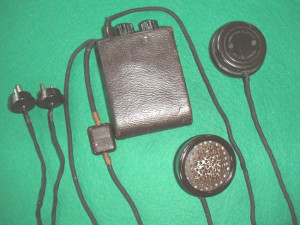
by Neil Bauman, Ph.D.
When I ask hard of hearing people when t-coils were first used in hearing aids (and thus providing the technology and impetus for the beginnings of loop systems), the response is, “I don’t have a clue.” or “Probably in the 1970s or so”.
In truth, the beginnings of t-coils go back almost 80 years! The very first hearing aid to have a t-coil (as far as is known) was the Tel-Audio table-top hearing aid made by the National Electrical Research and Mfg. Co. in Washington, DC way back in 1936.
This t-coil wasn’t the tiny coil of wire used in modern hearing aids. No sir! It was humongous by today’s standards. It was so big it was external to the hearing aid itself—housed in a separate Bakelite case measuring 4.6″ x 2.8″ x 1.8″ (11.8 x 7.3 x 4.5 cm).
 Two years later, in 1938, the Multitone Electric Co. Ltd. of London, England, came out with their Vest Pocket Model (VPM) that contained an internal t-coil. This was the first wearable hearing aid that had a t-coil. The model shown here is the 1937 Multitone Model “VPM” hearing aid that did not have a t-coil, but looked very similar to the t-coil model.)
Two years later, in 1938, the Multitone Electric Co. Ltd. of London, England, came out with their Vest Pocket Model (VPM) that contained an internal t-coil. This was the first wearable hearing aid that had a t-coil. The model shown here is the 1937 Multitone Model “VPM” hearing aid that did not have a t-coil, but looked very similar to the t-coil model.)
Wearable hearing aids with internal t-coils weren’t manufactured in America until 1946 when RadioEar, then based in Mt. Lebanon, PA, came out with their Permo-Magnetic Multipower (PM) 3-vacuum-tube hearing aid that contained an internal t-coil.
For the first number of years, t-coils were used exclusively to help people hear on telephones—hence the name “T-coil”. The “T” stood for telephone.
Eventually, someone discovered other uses for them. For example, by 1956, t-coils were being used to listen to radios and TVs via small loop pads.
 Here is an example of a miniature loop pad that Sonotone Corp. of Elmsford, NY produced around 1956. To use it, you clamped the two alligator clips across the terminals of the radio or TV’s loudspeaker. Then you switched on the t-coil and placed the body-worn hearing aid on the loop pad instead of in your pocket and voila, you had a simple loop system. (I acquired the loop pad shown here along with this Sonotone Model 200 4-transistor body-worn hearing aid that came out in 1956.)
Here is an example of a miniature loop pad that Sonotone Corp. of Elmsford, NY produced around 1956. To use it, you clamped the two alligator clips across the terminals of the radio or TV’s loudspeaker. Then you switched on the t-coil and placed the body-worn hearing aid on the loop pad instead of in your pocket and voila, you had a simple loop system. (I acquired the loop pad shown here along with this Sonotone Model 200 4-transistor body-worn hearing aid that came out in 1956.)
I don’t know when the first room loop was made, but I was introduced to the wonders of room loop systems from reading a short article in an Amateur Radio magazine in 1971 so they were starting to be known by then. (I’d had t-coils in my hearing aids from sometime in the 1960s, but had never come across a use for them apart from the telephone until this time.) This primitive room-loop sounded good to me. As a result, I built my first home loop system that same year so I could hear my TV without blasting my new bride out of the house! Thus I’ve been using room loops now for going on 45 years!

I PURCHASED HEARING AIDS FOR BOTH YEARS AND BEGAN TO NOTICE A PROBLEM. MY AUDIOLOGIST SENT ME TO A DOCTOR WHO PRESCRIBED A CREAM TO DESENTIZE MY INNER EARS. THIS DID NOT WORK. SHE THEN CUT THE TUBES THAT WHERE GOING INTO MY EARS AND THE HEARING AID WERE BETTER BUT OFTEN FELL OUT OF MY EARS AS THEY ARE NOT SECURE. SHE ALSO TOLD ME ONLY 1% OF ALL WHO WEAR HEARING AIDS HAVE THIS ALLERGIC REACTION TO THE TUBES. iS THERE ANY OTHER WAY OF HAVING THE TUBES THAT I CAN TOLERAIE OR AM NOT ALLERGIC TO PUT ON TO MY HEARING AIDS. I HAVE NOT BEEN WEARING THEM BECAUSE OF THIS ALLERGIC REACTION.
Was not the T coil, first used/developed by AG Bell and others in telephones much earlier than in hearing aid technology?
Hi Kirby:
I don’t think you really understand what a t-coil is when you ask such a question. What would be the purpose of a t-coil if you didn’t have a hearing aid? A telephone didn’t need a t-coil at all. Early telephones consisted of a carbon microphone and basically a loudspeaker earphone. This earphone consisted of a coil of wire and diaphragm. The coil of wire (voice coil) was wired as an electromagnet that attracted and repelled the diaphragm thus creating sound waves in the air that you heard. So where’s the t-coil?
Now, if you wanted a hearing aid to be able to pick up the magnetic field created by the voice coil, you needed a second coil of wire that was inside this magnetic field and was acting as an input to the hearing aid. This second coil of wire that was in the hearing aid acted as the secondary winding of a transformer and generated an equal but opposite magnetic field. (The two coils were separated by air.) This is the t-coil–the “t” referring to telephone.
So the telephone came first and in 1936 the first hearing aid was designed with a t-coil to couple to the telephone so hard of hearing people could hear on telephones.
Cordially,
Neil